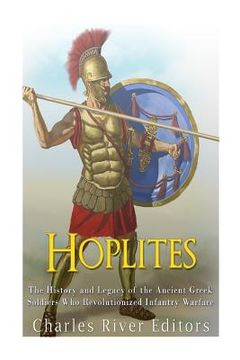Hoplites: The History and Legacy of the Ancient Greek Soldiers Who Revolutionized Infantry Warfare (in English)
Synopsis "Hoplites: The History and Legacy of the Ancient Greek Soldiers Who Revolutionized Infantry Warfare (in English)"
*Includes pictures *Includes online resources and a bibliography for further reading "The walls of Sparta were its young men, and its borders the points of their spears." - attributed to King Agesilaos Although the armies of the ancient Greek, or "Hellenic", city-states (poleis, singular polis) included both cavalry (hippeis) and light infantry (psiloi, peltastes, gymnetes), their mainstay was undoubtedly the heavy infantry known today as hoplites. Armed to the teeth with their distinctive round shield (aspis or hoplon), high-crested helmet (corys) and long spear (dory), the hoplites were some of the most efficient soldiers of their time. They fought in the tight phalanx formation, and beyond the confines of their small poleis, Greek hoplites were also prized as mercenaries throughout the ancient world. Most historians believe that the hoplite became the dominant infantry soldier in nearly all the Greek city-states around the 8th century BCE. Hoplites were responsible for acquiring their own equipment, so not every hoplite might have been equally armed, but considering the style of warfare, they needed as much uniformity as possible. Like most infantry outside of Greece, the hoplites also carried spears, but while the Persian weapons were short and light for example, the Greek spears were thick shafts anywhere between seven and nine feet long. These spears were topped by a 9-inch spearhead, with a "lizard-sticker" buttspike at the bottom which could be used as a secondary spearhead if the main weapon was snapped off, or to plant the spear upright when at rest. Each hoplite also carried a shortsword, designed specifically for thrusting in the close confines of a melee (the Spartan weapon, the xiphos, was so short as to be virtually a dagger, its blade barely over a foot long). For the Greeks, a hoplite was only as strong as the hoplite next to him; without hoplites on the sides, both flanks were exposed, and heavy infantry units are not mobile. Thus, they implemented the phalanx formation, one of history's most important military innovations. The phalanx was a line of infantry as wide across as the battlefield dictated, anything from five to 30 men deep, with each rank of men officered by a veteran. The formation also included an additional, expert file-closer at the back of each file, to keep the formation cohesive. The Spartans, due to the ferocity of their training and the intensity of their drill, were peerless at phalanx warfare. They were Greece's only full-time soldiers, with most other cities fielding citizen militias instead, so they avoided the traditional hoplite problem of edging to the right, into the "shadow" of their rankmate's shield. This edging meant that undisciplined formations often found themselves outflanked, and all armies, including the Spartans, fielded their elite unit (in the Spartans' case the hippeis) to the far right to keep the line steady. The left was traditionally reserved for the skiritai, the Spartan rangers, who considered it their post of honor. It was only with the advent of the more mobile Roman legion, and the defeat of phalanxes in battles like Cynoscephalae (197 BCE) and Pydna (168 BCE), that the hoplite phalanx was finally outclassed, although not without a long fight: the last of Alexander's successor kingdoms, Ptolemaic Egypt, only fell in 31 BCE. Hoplites: The History and Legacy of the Ancient Greek Soldiers Who Revolutionized Infantry Warfare examines how hoplites changed the world. Along with pictures depicting important people, places, and events, you will learn about hoplites like never before.

